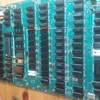Hi, I have an Apple II plus that only displays vertical white lines. Ive tested almost all the chips with my TL866 II plus programmer besides the 9334 chip. Ive tested with only the Autostart rom, nothing. Ive replaced sockets, replaced the CPU, and still nothing. CPU is attempting to do something, and has the right clock speed.
I have no clue what to do next. Im new to Apple Computers, but familiar with retro computers and their operations. No beeps, no clicks, nothing.
Im unable to test with my logic analyzer due to it being broken.
I've also checked circuit diagrams, service notes and troubleshooting guides. None of them help.
At this point I'm open to any suggestions.
(Also pardon my terrible formatting, I'm not used to using forums.)
-Derpy




Classic RAM issue. You could try moving chips from the upper RAM banks into the lowest one to see if you can get it to boot. Or try a "dead RAM" memory test like the one available on the ROMX or MultiROM boards.
Could also be the F8 ROM or CPU if you're not sure they're good.
ROMX no alpha.png
The RAM is new (relatively) and was known working when I got it. The ROM is something im unsure how to check. I can try and check if its the ROM, but It was also known working when I got the ROM.
It's not the ROM
You can check the 9334 chip as a 74LS259.
20230321_230808.jpg
Check the 74LS04 in position C11. More here: click!
What does that mean? Do you get a beep when you turn it on?
After doing some testing, I found out that the 2 8304s I had were bad, and pulling D3 and D2 to ground. After doing some rather testing with a 74ls145 Latch, I got data to work, but I still had garbage on the screen, which is a good step forward I suppose. And Im going to assume at this point, that the RAM is now probably bad even as it was new oldstock.
20230322_030058.jpg
d911b998-6c46-40ee-a5ca-2dd28252d0f8.jpg
Yep, one of the RAM chips is the issue now. I had the exact same problem when I first got my Apple II+: click!
I have this tester for 4116 DRAM ICs, it has been perfect when working on my II+ and is pretty affordable.
https://www.ebay.com/itm/255668038738
Actually the Apple II+ itself is a pretty good tester of RAM chips, since it will boot only with 16K (just the row of 8 closest to the keyboard). This makes it possible to find the bad RAM chips faster than testing them one by one with a tester. Also the RAM chips from the 16K language card can be used as spares during the testing.
Not only that, but a bad socket connection is just as often the culprit. The testing in the Apple II+ method finds those as well.
All great points and info! My 1st II+ had a Microsoft language card which also used 4116 ICs, so I decided on a standalone tester.
I'm with skate on this one.
Standalone testing of RAM chips in a good tester reveals a lot of issues that the Apple II cannot pick up from a simple bootup.
Stuck or dead bits are easy to see on bootup (but which chip is it? It could be any one of the eight in the lower 16K)
But what about zero-to-one transition problems or one-to-zero transition problems...those are tricky and usually show up as glitches in software.
I used to use the single-bank method to find bad RAM chips but I had to replace entire rows of RAM before I had a tester and put them all in a "suspect" bin. When I built my tester, I finally went through all the suspect chips and was able to rescue a good number of them to put back into service.
A good 4116 RAM tester is a vital tool.
As I mentioned earlier, testing chips one by one in a standalone tester cannot detect a bad socket, which happens just as often. The swapping method can at least tell you the row.
Once the machine boots, then the best tool I found is the Apple II RAM test utility. It will detect any problem that might manifest itself in software.
baldrick wrote:
Stuck or dead bits are easy to see on bootup (but which chip is it?
I agree that this is a great tool to exercise all of the RAM in your Apple II. That's why it's included in every ROMX product. But when there's a fault in the first bank of RAM and the computer won't boot, you need a "dead-RAM" test that can show you which chip(s) is bad. The Multi-ROM and ROMX boards have this as well (ROMX beeps out the location of the bad bit). Such a tool is a must for anyone who does frequent testing of Apple motherboards.